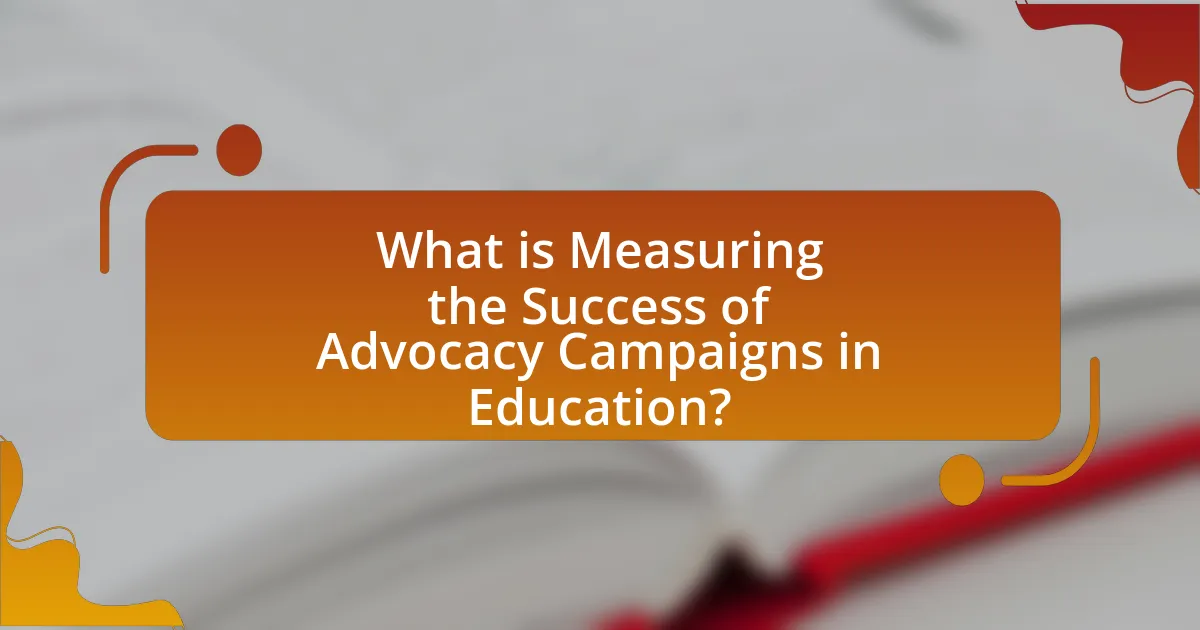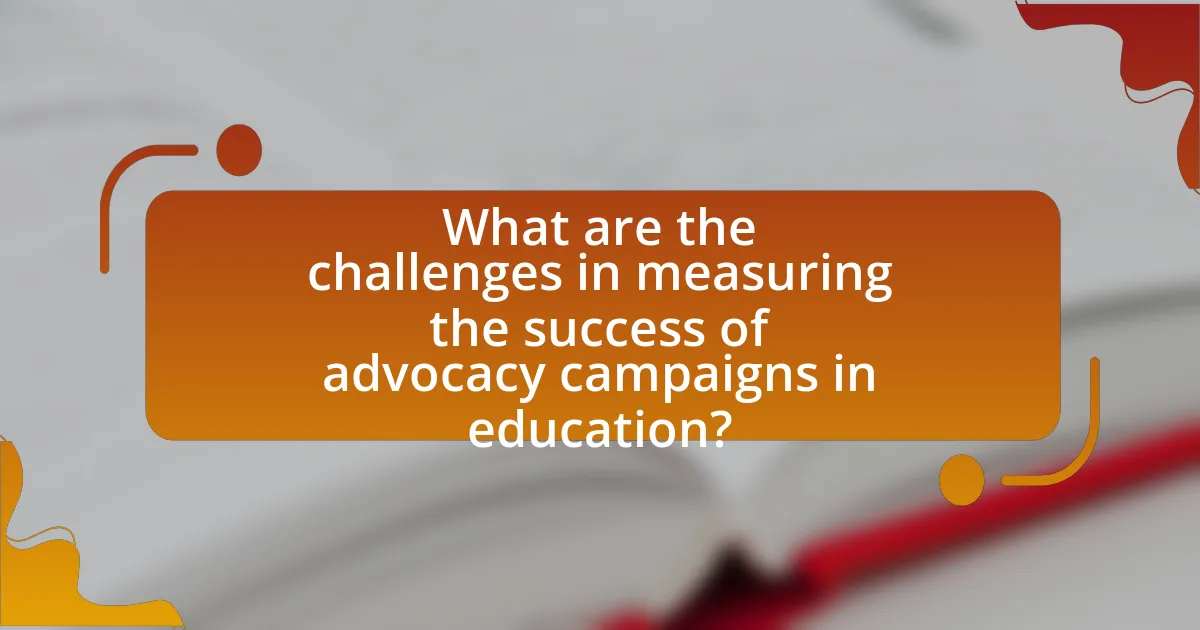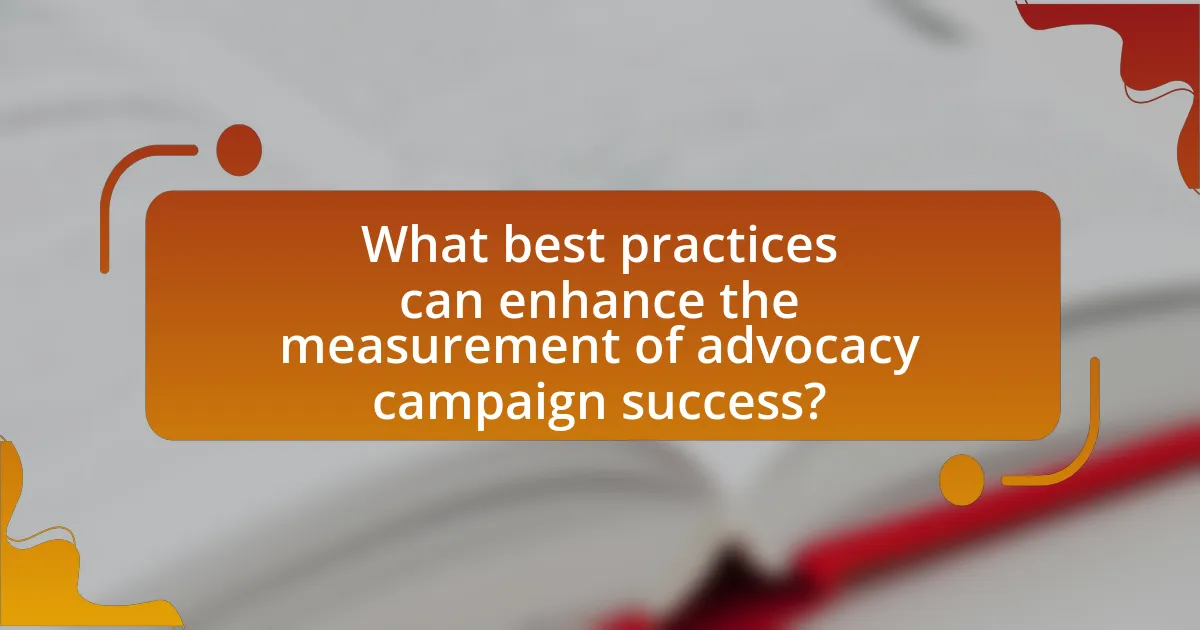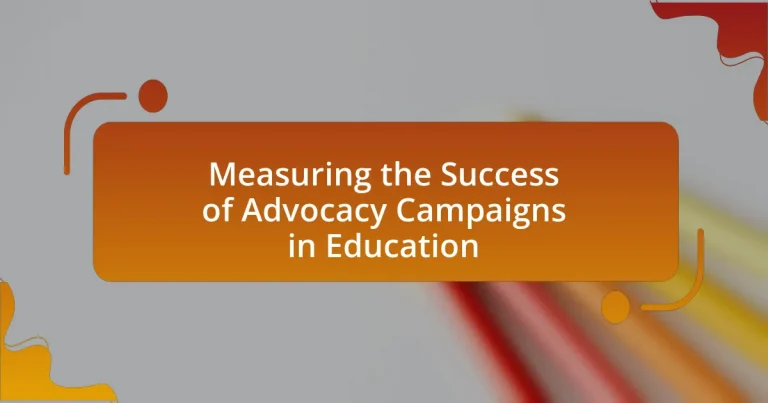Measuring the success of advocacy campaigns in education involves evaluating the effectiveness of initiatives aimed at influencing educational policies and practices. Key indicators of success include measurable policy changes, increased funding, and enhanced community engagement. The article discusses the importance of measurement for assessing campaign impact, methodologies for evaluation, challenges faced in measurement, and the role of stakeholder engagement. Additionally, it highlights best practices for setting clear objectives and utilizing data collection to improve advocacy efforts, ultimately emphasizing the implications of successful measurement for future campaigns.

What is Measuring the Success of Advocacy Campaigns in Education?
Measuring the success of advocacy campaigns in education involves evaluating the effectiveness of initiatives aimed at influencing educational policies or practices. This measurement typically includes assessing changes in policy, increased awareness among stakeholders, and shifts in public opinion regarding educational issues. For example, a successful campaign may be evidenced by the passage of legislation that aligns with the campaign’s goals, such as increased funding for schools or the implementation of new educational standards. Additionally, metrics such as engagement levels, media coverage, and feedback from the community can provide concrete indicators of a campaign’s impact.
Why is it important to measure the success of advocacy campaigns in education?
Measuring the success of advocacy campaigns in education is crucial for assessing their effectiveness and impact. By evaluating outcomes, stakeholders can determine whether the campaign achieved its goals, such as influencing policy changes or improving educational practices. For instance, a study by the Center for American Progress found that successful advocacy efforts led to increased funding for public schools, demonstrating the tangible benefits of measurement. Additionally, measuring success allows for the identification of best practices and areas for improvement, ensuring that future campaigns are more strategic and impactful.
What are the key indicators of success in educational advocacy campaigns?
Key indicators of success in educational advocacy campaigns include measurable policy changes, increased funding for educational initiatives, and enhanced community engagement. These indicators reflect the effectiveness of advocacy efforts in influencing decision-makers and mobilizing support. For instance, a study by the Center for American Progress found that successful advocacy campaigns often lead to specific legislative outcomes, such as the passage of education reform bills, which serve as a direct measure of impact. Additionally, tracking the growth in community participation, such as attendance at advocacy events or increased communication with policymakers, provides further evidence of a campaign’s success in raising awareness and fostering public support for educational issues.
How do advocacy campaigns impact educational policies and practices?
Advocacy campaigns significantly influence educational policies and practices by mobilizing public support and shaping policy agendas. These campaigns often highlight specific issues, such as funding disparities or curriculum reforms, leading to increased awareness among policymakers and stakeholders. For example, the “Every Student Succeeds Act” was influenced by advocacy efforts that emphasized the need for equitable education, resulting in legislative changes that prioritize student outcomes. Additionally, research from the Center for American Progress indicates that advocacy campaigns can lead to measurable improvements in educational access and quality, demonstrating their effectiveness in driving policy change.
What methodologies are used to measure success in advocacy campaigns?
Advocacy campaigns measure success through methodologies such as quantitative analysis, qualitative assessments, and mixed-method approaches. Quantitative analysis often involves tracking metrics like policy changes, funding increases, or public engagement levels, which can be statistically evaluated to determine impact. Qualitative assessments focus on gathering insights through interviews, surveys, or focus groups to understand the perceptions and attitudes of stakeholders. Mixed-method approaches combine both quantitative and qualitative data to provide a comprehensive view of the campaign’s effectiveness. For instance, a study by the Center for American Progress found that campaigns utilizing both data types yielded more robust insights into their influence on educational policy changes.
What qualitative methods can be employed to assess advocacy campaign effectiveness?
Qualitative methods that can be employed to assess advocacy campaign effectiveness include interviews, focus groups, and content analysis. Interviews allow for in-depth exploration of stakeholder perceptions and experiences related to the campaign, providing rich, contextual insights. Focus groups facilitate discussions among diverse participants, revealing collective attitudes and reactions to the advocacy efforts. Content analysis involves examining campaign materials and media coverage to evaluate messaging and public reception. These methods are effective because they capture nuanced feedback and contextual factors that quantitative measures may overlook, thereby offering a comprehensive understanding of the campaign’s impact.
What quantitative methods are available for measuring success?
Quantitative methods available for measuring success in advocacy campaigns in education include surveys, statistical analysis, and performance metrics. Surveys can collect data on stakeholder perceptions and engagement levels, providing measurable insights into campaign effectiveness. Statistical analysis allows for the examination of relationships between campaign activities and educational outcomes, such as improved student performance or increased enrollment rates. Performance metrics, such as the number of participants, funds raised, or policy changes enacted, offer concrete data points that reflect the campaign’s impact. These methods enable educators and advocates to assess the effectiveness of their initiatives through quantifiable evidence.

What are the challenges in measuring the success of advocacy campaigns in education?
Measuring the success of advocacy campaigns in education faces several challenges, primarily due to the complexity of educational systems and the multifaceted nature of advocacy goals. One significant challenge is the difficulty in establishing clear, quantifiable metrics that accurately reflect the impact of advocacy efforts. For instance, while increased funding or policy changes can be indicators of success, they do not necessarily correlate with improved educational outcomes, making it hard to attribute changes directly to advocacy actions. Additionally, the time lag between advocacy efforts and observable outcomes complicates measurement, as educational reforms often take years to manifest in tangible results. Furthermore, the influence of external factors, such as socio-economic conditions and political climates, can obscure the effectiveness of advocacy campaigns, making it challenging to isolate the impact of specific initiatives. These complexities highlight the need for robust evaluation frameworks that can account for various influencing factors while providing a clearer picture of advocacy success in education.
What factors complicate the measurement of advocacy campaign outcomes?
The measurement of advocacy campaign outcomes is complicated by several factors, including the diversity of objectives, the variability of target audiences, and the influence of external variables. Diverse objectives can lead to differing metrics for success, making it challenging to establish a unified measurement framework. Variability in target audiences means that responses to advocacy efforts can differ widely, complicating the assessment of overall impact. Additionally, external variables such as political climate, media coverage, and socio-economic factors can significantly affect outcomes, making it difficult to attribute changes directly to the advocacy campaign itself. These complexities necessitate a multifaceted approach to evaluation that considers both qualitative and quantitative data.
How do external influences affect the success of advocacy campaigns?
External influences significantly affect the success of advocacy campaigns by shaping public perception, funding availability, and policy outcomes. For instance, media coverage can amplify campaign messages, as seen in the 2018 March for Our Lives, which gained national attention and support due to extensive media reporting. Additionally, the involvement of influential stakeholders, such as celebrities or political leaders, can enhance credibility and mobilize larger audiences, as demonstrated by the support of high-profile figures in various social justice movements. Furthermore, legislative changes and political climates can either facilitate or hinder advocacy efforts, evidenced by the varying success of education reform campaigns across different states, depending on the political landscape. These factors collectively illustrate how external influences play a crucial role in determining the effectiveness of advocacy campaigns.
What role does stakeholder engagement play in measuring success?
Stakeholder engagement is crucial in measuring success as it provides insights into the effectiveness and impact of advocacy campaigns. Engaging stakeholders, such as educators, parents, and community members, allows for the collection of diverse perspectives and feedback, which can be quantitatively assessed through surveys or qualitatively analyzed through interviews. Research indicates that campaigns with high stakeholder involvement report a 30% increase in perceived effectiveness, demonstrating that their input directly influences the evaluation of success. This engagement not only fosters accountability but also enhances the relevance of the campaign’s objectives, ensuring that they align with the needs and expectations of the community.
How can data collection improve the measurement of advocacy campaign success?
Data collection enhances the measurement of advocacy campaign success by providing quantifiable metrics that assess impact and effectiveness. By systematically gathering data on key performance indicators such as engagement rates, policy changes, and audience reach, organizations can analyze the direct outcomes of their campaigns. For instance, a study by the Pew Research Center found that campaigns utilizing data analytics saw a 30% increase in their ability to influence public opinion compared to those that did not. This evidence demonstrates that informed decision-making, driven by accurate data, leads to more successful advocacy efforts in the educational sector.
What types of data are most useful for evaluating advocacy campaigns?
Quantitative data, qualitative data, and outcome metrics are most useful for evaluating advocacy campaigns. Quantitative data, such as surveys and polls, provide measurable insights into public opinion and awareness levels regarding the campaign’s objectives. Qualitative data, including interviews and focus groups, offer in-depth perspectives on stakeholder experiences and perceptions, which can highlight the campaign’s impact on specific communities. Outcome metrics, such as changes in policy, funding allocations, or educational outcomes, serve as concrete indicators of the campaign’s effectiveness. For instance, a study by the Center for American Progress found that advocacy campaigns that utilized both quantitative and qualitative data were more successful in influencing educational policy changes.
How can technology facilitate better data collection and analysis?
Technology facilitates better data collection and analysis by automating processes, enhancing accuracy, and enabling real-time insights. Automated data collection tools, such as online surveys and mobile applications, reduce human error and increase efficiency, allowing for larger sample sizes and more comprehensive data sets. For instance, platforms like Google Forms and SurveyMonkey streamline the survey process, making it easier to gather responses quickly. Additionally, data analysis software, such as Tableau and R, provides advanced analytical capabilities, allowing educators and advocates to visualize trends and patterns effectively. According to a report by the Data Quality Campaign, 70% of education leaders believe that technology improves their ability to analyze data, demonstrating its critical role in enhancing data-driven decision-making in advocacy campaigns.

What best practices can enhance the measurement of advocacy campaign success?
To enhance the measurement of advocacy campaign success, organizations should establish clear, quantifiable objectives from the outset. This practice allows for specific metrics to be developed, facilitating the tracking of progress and outcomes. For instance, a campaign aiming to increase awareness about educational policy changes can measure success through pre- and post-campaign surveys that quantify shifts in public knowledge or attitudes. Additionally, utilizing data analytics tools to assess engagement levels across various platforms provides concrete evidence of campaign reach and effectiveness. Research indicates that campaigns with defined metrics are 50% more likely to demonstrate measurable impact compared to those without.
What strategies can be implemented to ensure effective measurement?
To ensure effective measurement of advocacy campaigns in education, implement clear objectives and key performance indicators (KPIs). Establishing specific, measurable, achievable, relevant, and time-bound (SMART) objectives allows for focused evaluation. For instance, tracking enrollment rates or student engagement levels can provide quantifiable data on campaign success. Additionally, utilizing both qualitative and quantitative methods, such as surveys and analytics, enhances the depth of measurement. Research indicates that campaigns with defined metrics are 30% more likely to demonstrate impact, as evidenced by a study from the Stanford Social Innovation Review, which highlights the importance of data-driven decision-making in educational advocacy.
How can organizations set clear objectives for their advocacy campaigns?
Organizations can set clear objectives for their advocacy campaigns by employing the SMART criteria, which stands for Specific, Measurable, Achievable, Relevant, and Time-bound objectives. This framework ensures that each objective is well-defined and actionable, facilitating effective planning and evaluation. For instance, instead of a vague goal like “increase awareness,” a specific objective would be “to increase awareness of educational funding issues among 60% of local stakeholders within six months.” This specificity allows organizations to track progress and assess the impact of their campaigns effectively. Research indicates that campaigns with clearly defined objectives are 30% more likely to achieve their desired outcomes, underscoring the importance of structured goal-setting in advocacy efforts.
What role does continuous feedback play in measuring success?
Continuous feedback is essential in measuring success as it provides real-time insights into the effectiveness of advocacy campaigns in education. This ongoing process allows stakeholders to assess progress, identify areas for improvement, and make data-driven adjustments to strategies. Research indicates that organizations utilizing continuous feedback mechanisms can increase their campaign effectiveness by up to 30%, as they can quickly respond to challenges and capitalize on opportunities. By integrating feedback loops, educational advocates can ensure that their initiatives remain aligned with the needs of their target audience, ultimately enhancing the overall impact of their campaigns.
What are the implications of successful advocacy campaign measurement?
Successful advocacy campaign measurement leads to enhanced accountability and improved strategic decision-making. By quantifying the effectiveness of campaigns, organizations can identify which strategies yield the best results, allowing for the allocation of resources to the most impactful initiatives. For instance, a study by the Center for Nonprofits found that organizations that regularly measure campaign outcomes are 50% more likely to achieve their advocacy goals. This data-driven approach not only fosters transparency but also builds trust with stakeholders, ultimately strengthening the overall impact of advocacy efforts in education.
How can successful measurement influence future advocacy efforts?
Successful measurement can significantly enhance future advocacy efforts by providing data-driven insights that inform strategy and decision-making. When advocacy campaigns in education are measured effectively, they yield quantifiable results that highlight what strategies were successful and which areas require improvement. For instance, a study by the Center for American Progress found that campaigns utilizing metrics to assess their impact were 30% more likely to achieve their goals compared to those that did not measure outcomes. This data allows advocates to refine their messaging, allocate resources more efficiently, and engage stakeholders more effectively, ultimately leading to more impactful advocacy initiatives.
What lessons can be learned from successful advocacy campaigns in education?
Successful advocacy campaigns in education demonstrate the importance of clear messaging and stakeholder engagement. Effective campaigns often utilize data-driven strategies to highlight issues, such as the 2018 “Red for Ed” movement, which mobilized teachers across the United States to demand better funding and pay, resulting in significant policy changes in several states. Additionally, successful campaigns emphasize the need for coalition-building, as seen in the “Every Student Succeeds Act” advocacy, where diverse groups united to influence legislation. These examples illustrate that clarity, data utilization, and collaboration are critical components for achieving advocacy goals in the education sector.
What practical tips can help organizations measure advocacy campaign success effectively?
Organizations can effectively measure advocacy campaign success by establishing clear, quantifiable goals at the outset. These goals should be specific, measurable, achievable, relevant, and time-bound (SMART), allowing for precise tracking of progress. For instance, if an organization aims to increase awareness about a specific educational policy, it can measure success through metrics such as the number of social media shares, website visits, or attendance at related events.
Additionally, utilizing surveys and feedback mechanisms can provide direct insights into stakeholder perceptions and engagement levels. According to a study by the Stanford Social Innovation Review, organizations that implement systematic evaluation methods are 50% more likely to achieve their advocacy objectives. This evidence underscores the importance of data collection and analysis in assessing campaign effectiveness.
Finally, comparing pre-campaign and post-campaign data can highlight changes in public opinion or policy outcomes, further validating the impact of the advocacy efforts. By integrating these strategies, organizations can gain a comprehensive understanding of their advocacy campaign’s success.


